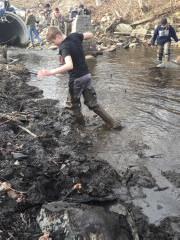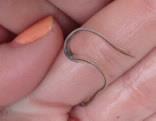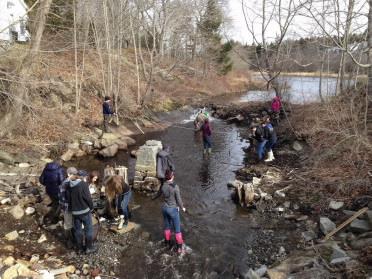Students at St. George School are taking advantage of spring by getting outside to measure their local stream! Check out their findings below!
By Jake Paulsen and Hunter Hoppe
 When we went down to the marsh to practice measuring the stream, it was fun and interesting at the same time. It was a beautiful morning with geese flying over us. We got a chance to use our brand new hip boots that Mrs. England bought the class using the grant money from the Natural Resources Council of Maine. It was a lot of fun because we kept getting stuck in the mud in one area. Once Hunter’s boot actually came off he was so stuck.
When we went down to the marsh to practice measuring the stream, it was fun and interesting at the same time. It was a beautiful morning with geese flying over us. We got a chance to use our brand new hip boots that Mrs. England bought the class using the grant money from the Natural Resources Council of Maine. It was a lot of fun because we kept getting stuck in the mud in one area. Once Hunter’s boot actually came off he was so stuck.
Our measurements are helping us figure out how much water is flowing and how fast the water is flowing. We want to see if it’s enough flow for the alewives to be able to migrate through the culvert.
Jake and I wanted the middle 20’ section because it had a lot of mud. When we were measuring the water depth there wasn’t really that much of a difference in depth as we moved across the width of the stream in our section. Other sections were different from ours. Because the sections of stream are different, one of the first things we had to figure out was which 20’ section to measure. The top 20’ section is the deepest part. The last 20’ section is all rock and is pretty shallow. We are going to average our measurements from the three different sections when we calculate how much water is flowing from the marsh, through the culvert.
Updates
Jake Paulsen– April 30
We have gone outside two different days to make measurements that we are recording as data. We have to go when it’s low tide so that we are actually measuring the amount of water coming out of the marsh and not the influence of the tide.

An elver caught in the stream
One unexpected thing we found were elvers (juvenile eels) swimming upstream when we were finding out the measurements. They were pretty easy to see because the water was clear, so we would try and catch them. Just one of the days we caught eleven elvers. To catch them we would stir up the mud and all kinds of them would come up and we would use our hands to try and catch them. They weren’t that big but with all of them in the little container they all added up. We should bring a little net next time and see how many we could get and then put them back in the marsh.
Calculating Stream Flow
Greta Carlson, Jake Paulsen – May 2nd
 We measured three different sections of the stream and found the width, length, depth, and surface velocity of the sections we measured. To find the depth, we measured the width across our section of the stream, and measured how deep the water was with a yardstick at one-foot intervals. We added the depths together to find the sum of depths. We divided the sum by the number of one-foot intervals we took to find the average depth. Then we multiplied the average depth by the width of our section to find the cross-sectional area. We had to put in a “correction value” because the bottom of the stream was muddy and uneven. To find the surface velocity, we took a tennis ball and a stopwatch, and we floated the tennis ball down the length of our stream section. We recorded how long it took for the tennis ball to go from the beginning to the end of our section. Then, to find the average float time, we added the time (in seconds) together and divided it by the number of trials we did. Then we multiplied the cross-sectional area by the surface velocity to get the stream flow in cubic feet per second (rounded to the nearest tenth).
We measured three different sections of the stream and found the width, length, depth, and surface velocity of the sections we measured. To find the depth, we measured the width across our section of the stream, and measured how deep the water was with a yardstick at one-foot intervals. We added the depths together to find the sum of depths. We divided the sum by the number of one-foot intervals we took to find the average depth. Then we multiplied the average depth by the width of our section to find the cross-sectional area. We had to put in a “correction value” because the bottom of the stream was muddy and uneven. To find the surface velocity, we took a tennis ball and a stopwatch, and we floated the tennis ball down the length of our stream section. We recorded how long it took for the tennis ball to go from the beginning to the end of our section. Then, to find the average float time, we added the time (in seconds) together and divided it by the number of trials we did. Then we multiplied the cross-sectional area by the surface velocity to get the stream flow in cubic feet per second (rounded to the nearest tenth).











Leave a Reply